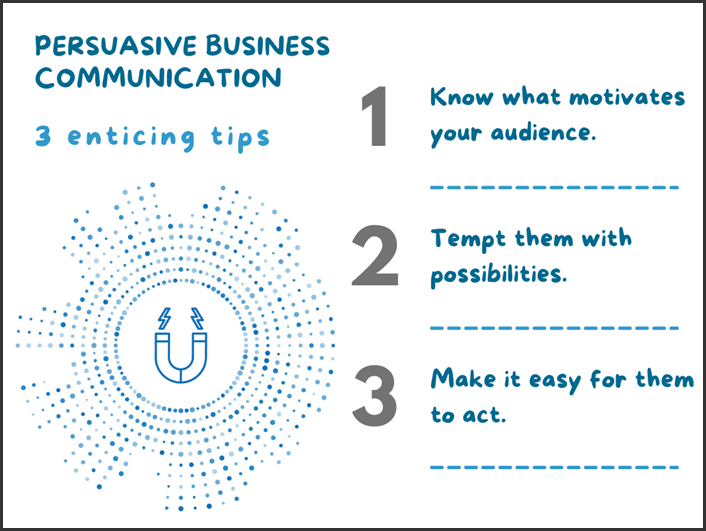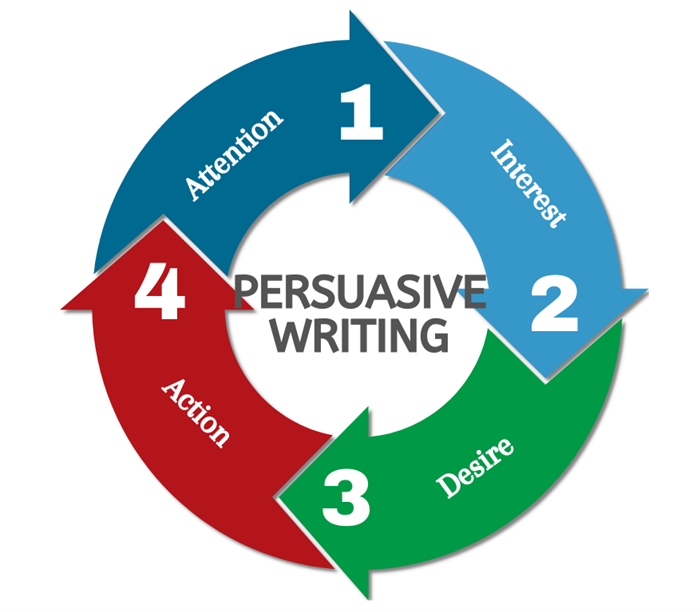 Were you persuasive as a child? Think back to when you really, really wanted something.
Were you persuasive as a child? Think back to when you really, really wanted something.
You pleaded with Mom or Dad to delay bedtime. Or rationalized why you needed the latest game. You needed them to believe you were right.
If we could hold on to a child’s persuasive focus, we would all be better negotiators.
Now, imagine if every ad, post, or article you wrote induced others to believe you were right. It is a marketer’s dream.
Persuasive Language in Action
The art of persuasion is a coveted skill. Ever since the serpent convinced Eve to bite into that apple, humans have worked on their own persuasive techniques.
Persuasive language hopes to influence people in their thinking. You hope you convince them to take a certain action. Like a later bedtime. Or buying your latest product.
Build persuasive communication by focusing on three fundamentals.
Illustrated below is another model for persuasive writing, known by the acronym, AIDA. It has four elements to my three. But they are essentially the same. Choose what works best for you.
Ensuring the person feels good about his or her decision is one of the tricks of persuasive language. A gun to the head may get the job done but is that what you’re aiming at?
The following are seven techniques for generating persuasive business communication. In the spirit of our alphabetical journey, I listed them in alphabetical order.
1. Active voice
Ah, where have you heard active voice before? Could it be your elementary school teacher was right?
Active voice is the engine that revs up your audience. Keep it simple, clear, and unique for a persuasive touch.
Example
Instead of: The product is being released August 1.
Substitute: The product launches August 1.
Launch takes charge. Being released depends on your captor. Which would you choose?
2. Alliteration
Alliteration is fun and reinforces your message. It repeats the same letter or sound at the beginning of words. Alliteration grabs your audience’s attention and helps them remember your business communication.
Example
Businesses use alliteration in company names and products – Bed, Bath & Beyond, Krispy Kreme, Super-size, Minute Maid
Bonus Techniques
Assonance repeats the same vowel sound – YouTube, how now brown cow.
Consonance repeats the same consonant within the same word – or in the middle or end of multiple words – Twitter glitter.
3. Anecdotes
Anecdotes are short, often personal, stories that help your audience relate to you and your topic. You know everyone loves a good story.
Example
Billy Blanks, Jr. pitched his and his wife’s fitness program on the TV show, Shark Tank. Billy shared his story of being homeless when they started. Yet, he and his wife persevered. It was a persuasive anecdote to his character that resonated with the Sharks.
4. Anticipation
Do you know the adage, “the best defense is a good offense”? This persuasive technique anticipates what objections your audience may have and addresses each upfront.
Example
In the latter part of my corporate career, I worked for a small insurance brokerage firm. Our salespeople knew prospects questioned how our small firm could compete against the large, international brokerage firms.
- We highlighted our independent, strategic partnerships. How did that help?
- Unlike large firms that typically had a single platform, our firm offered multiple platforms through our partnerships.
- So, our flexible structure allowed us to collaborate with other companies for a customer-specific approach.
Anticipate the objection – respond with an alternative.
5. Bandwagon/Inclusive
Few people enjoy being outsiders.
- We want to feel we belong.
- That we’re cool.
- And I am so “uncool”with that boomer term.
By using inclusive language, your audience can be cool, too. If so many people like a product, it must be good, right?
Example
- BBC, the World’s Newsroom
- Wall Street Journal, the Daily Diary of the American dream
- Uber, Everyone’s Private Driver
6. Rhetorical
Imagine the response –DUH – and you probably answered a rhetorical question. But effective rhetorical questions can elicit persuasive pause.
Readers know the question is rhetorical but want your answer to their problem.
Example
Wish you could stop spam before it strikes? Who doesn’t, right? DUH.
7. Why?
One of the simplest but often missed persuasive techniques is explaining why.
- Why should readers believe you?
- Why should buyers purchase your product?
- Why should people care about your message?
Want a simple reminder? Finish this thought…Because…
Example
- Why go with Verizon? Because…Better Matters.
- Why choose Avis over another car rental company? Because…We try harder.
Of course, you need more than the words. You need to prove it. With service, testimonials, and customer loyalty.
Postscript
The above is a super-short sample of persuasive language. Have I convinced you of the value of persuasive language?
Share your favorite persuasive techniques in Comments.
Oh, if you like a challenge, I sprinkled a potpourri of persuasive techniques throughout this post. How many can you find?
==================================
Note: In 2015, SSB took a year-long alphabetic journey for better business communication. Each post contained an A-to-Z topic for creating better business communication. This ‘P’ post originally published on August 10, 2015, and this June 5, 2022 version updates it. The plan is to update each alphabetic post. Hopefully, it will not take a year to complete. 😊
===================================




These are great tips, Cathy. After all, we all write because we want to communicate and educate. We want folks to either spend their money or their time regarding what we’ve written.
How can we not include these concepts in our repertoire?
Thank you kindly, Roy. I love this ~ We want folks to either spend their money or their time regarding what we’ve written. Well said. 😉
I really enjoy persuasive writing (for a while in high school I wanted to be a lawyer, before I attended one meeting of a Future Lawyer’s group and realized it involved a lot more than arguing cases). An important part is not to denigrate your audience – one whiff of condescension, desperation, anger, or smug superiority and you’ve lost them.
Tom Sawyer was the master of persuasion. Cathy replaced him.
Oh, aren’t you sweet, Paula? 🙂 And you are spot on about not denigrating your audience. It sounds obvious but at times the person communicating doesn’t even realize they are doing that.
Thanks for your thoughts, Paula.
P.S. You would have made a persuasive prosecutor. 😉
Lol, I’m with Paula, great plays on words.
Thanks, Anne. 🙂
Excellent tips, Cathy, all of them. I especially love the bandwagon one for social proof. People always want what other people have, right? 🙂 Also, I like to use imagery — having the audience imagine how much easier/better life would be if they implemented/bought whatever it was the writing promoted.
Thank you, Ashley. Love the imagery idea. Thanks for sharing that. 🙂
These are excellent tips and great reminders, Cathy. The one I always need to remind myself of is the enticing, things like “six ways to proofread, and one way you should never use.” People will want to know the six ways, but they will feel compelled to find out what the wrong way is so they can avoid it.
Thanks for this helpful content.
Lynn
Thank you, Lynn. Great tip on including the “wrong way”. We do like to avoid getting egg on our face. 😉 I appreciate you stopping by and sharing your thoughts.